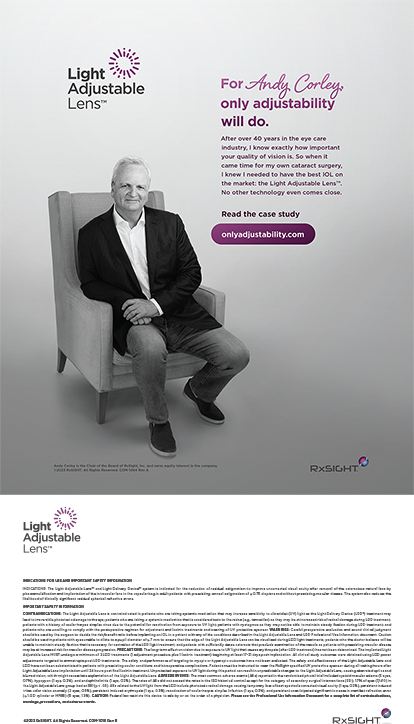
Cataract surgery presents unique challenges in patients with retinal disease. This is particularly true for those who have undergone retinal procedures, the most common of which is pars plana vitrectomy (PPV). Special consideration is also due patients who have received intravitreal injections for the treatment of age-related macular degeneration and who need cataract surgery. Proper planning, surgical technique, and postoperative management allow anterior segment surgeons to deliver optimal care and results to these patients.
CATARACT FORMATION or progression
Cataract formation or progression is the most frequent complication of PPV; it affects up to 100% of patients within 2 years postoperatively.1,2 Nuclear sclerosis always occurs, and the formation of a posterior subcapsular cataract is common. Rarely, a white cataract develops rapidly when the posterior capsule is damaged. Posterior capsular opacification or plaque also frequently occurs after PPV, especially when the procedure involves the use of gas or silicone oil, and this complication may degrade patients’ vision after cataract removal.
The indication for a PPV is usually a significant retinal problem that can limit a patient’s visual potential and that may progress or recur in the future. Patients with age-related macular degeneration have a similarly uncertain visual prognosis, and they can develop a cataract if the posterior capsule is punctured during intravitreal injection.
The impact of retinal disease must be evaluated during the cataract consultation and clearly explained to patients preoperatively.
RISK FACTORS
The structural changes in vitrectomized eyes increase the risk of complications during cataract surgery. For example, the lack of vitreous softens the eye, increases capsular mobility, and deepens the anterior chamber. Damage to zonular fibers from stretching (ie, from expansile gas) or dehiscence can destabilize the lens and cause fluctuations in anterior chamber depth.
The integrity of the capsule may be compromised if there was direct injury from vitrectomy instruments. Additionally, accelerated nuclear sclerosis often results in a nucleus that is harder than an age-related cataract. All of these factors can contribute to a variable visual prognosis.
PREPARATION
Cataract surgery after retinal procedures requires careful preparation that starts with a detailed history of previous and/or current retinal disease and treatment, the visual acuity before and after procedures, and the onset of visual symptoms (days to weeks suggests an injury to the posterior capsule). Old records are helpful if a patient is unable to provide this information.
Tests can aid in determining a patient’s visual potential and the effects of retinal pathology. Examples include BCVA with pinhole, Amsler grid, pupillary testing, visual field testing, OCT, and fluorescein angiography. During the eye examination, it is important to assess the lens for phacodonesis; evaluate the type and grade of cataract; and look for posterior capsular opacification, plaque, or puncture. A thorough evaluation of the retina is warranted with attention to the macula, and a B-scan or retinal consultation may be necessary if the cataract prevents an adequate view.
After the examination, the anterior segment surgeon reviews the findings with the patient, makes a recommendation regarding cataract surgery, and sets appropriate expectations. Informed consent requires a detailed discussion of the limited visual outcome and increased risk of complications. Patients must understand that their retinal pathology may prevent them from recovering normal vision.
The timing of ongoing intravitreal injections should be coordinated before cataract surgery to ensure optimal results.
IOL CONSIDERATIONS
IOL power calculations are less accurate after PPV. The main source of error is uncertainty in predicting the effective lens position (ie, farther posterior owing to a deeper anterior chamber and to zonular and/or capsular instability). This may produce a hyperopic surprise. A longer axial length—common if the eye is myopic or has a scleral buckle—also contributes to unpredictability in IOL calculations. Corrective formulas and intraoperative wavefront aberrometry can help increase the accuracy of IOL power calculations for these eyes.3,4
The presence of silicone oil also affects IOL calculations. The velocity of immersion A-scan ultrasonography is slower through oil than vitreous. Either a silicone oil mode or a conversion equation must be used to obtain an accurate measurement. Otherwise, the axial length will be falsely long, resulting in a hyperopic outcome. Optical biometry devices have a setting for silicone oil that must be selected.
Another issue is that the refractive index of silicone oil causes a hyperopic shift.5 If the oil will remain in the eye indefinitely, then a higher-powered lens (ie, 3.00 to 3.50 D for a convex-plano IOL6) must be implanted to achieve the desired refractive result. Because silicone oil may migrate into the anterior chamber during or after the cataract procedure, a hydrophobic acrylic or PMMA IOL is recommended. A silicone lens is contraindicated because oil can adhere to its surface. Finally, a patent inferior iridectomy is necessary to prevent pupillary block.
SURGICAL TECHNIQUE
One main difference in postvitrectomy eyes is that zonular and capsular weakness cause fluctuations in anterior chamber depth. A deeper anterior chamber makes intraocular maneuvers more difficult, and eyes with increased axial length usually have deep anterior chambers, compounding the problem. When injecting an OVD, it is important not to overinflate the anterior chamber, which will deepen it further and stress the zonules.
Poor pupillary dilation is common in these eyes, so cataract surgeons must be ready to manage small pupils. Trypan blue dye is helpful during surgery on eyes with mature cataracts or if intraocular gas or oil interferes with the red reflex. The surgeon should assess the capsular response during the capsulorhexis surgical step to identify zonular weakness. Hydrodissection must be gentle, and if a posterior capsular defect is suspected, then only hydrodelineation should be performed. A large capsulorhexis facilitates lens prolapse out of the bag to reduce stress on the capsules and zonules during phacoemulsification. The insertion of a capsular tension ring or capsular tension segments may be necessary.
Other modifications can facilitate cataract surgery in eyes with a history of PPV. During phacoemulsification, reducing irrigation (ie, lower bottle height) and decreasing the aspiration flow rate help to alleviate anterior chamber instability and prevent postocclusion surge. If reverse pupillary block develops, lifting the iris with a second instrument may remedy the problem.
It is important to understand that the capsule may respond abnormally during irrigation and aspiration. Cortical cleanup is especially difficult when a gas bubble pushes the posterior capsule anteriorly, collapsing the bag. Expanding the bag with an OVD and manually removing the cortex with a cannula may be easier. Care should be taken when polishing the posterior capsule to avoid a tear. An adherent plaque is best treated in the future with an Nd:YAG laser capsulotomy.
It may be necessary to place the IOL in an alternate location such as the sulcus with or without optic capture and/or suture fixation. If an injury to the posterior capsule in an eye with an acute-onset white cataract is suspected, a referral for pars plana lensectomy may be the safest approach (see Watch It Now). Otherwise, the anterior segment surgeon should be prepared to encounter a ruptured posterior capsule and possible vitreous loss and retained lens material.
Zack Oakey, MD, demonstrates a lensectomy procedure after cataract removal.
POSTOPERATIVE CARE
After surgery, appropriate care is essential for preventing and managing problems. Visual recovery may be slower than in standard cases, particularly if intraoperative complications occurred. It is therefore important to communicate clearly with patients and address concerns. Those with macular pathology, retinal vein occlusion, or diabetes are at increased risk of cystoid macular edema and may require extended treatment with a topical NSAID and steroid.
A now unobstructed view of the retina will permit a better examination and determination of visual potential. Follow-up care with a retina specialist should be arranged as necessary.
1. Do DV, Gichuhi S, Vedula SS, Hawkins BS. Surgery for postvitrectomy cataract. Cochrane Database Syst Rev. 2018;1(1):CD006366.
2. Cheng L, Azen SP, El-Bradey MH, et al. Duration of vitrectomy and postoperative cataract in the vitrectomy for macular hole study. Am J Ophthalmol. 2001;132(6):881-887.
3. Wang L, Shirayama M, Ma XJ, Kohnen T, Koch DD. Optimizing intraocular lens power calculations in eyes with axial lengths above 25.0 mm. J Cataract Refract Surg. 2011;37(11):2018-2027.
4. Hill DC, Sudhakar S, Hill CS, et al. Intraoperative aberrometry versus preoperative biometry for intraocular lens power selection in axial myopia. J Cataract Refract Surg. 2017;43(4):505-510.
5. Stefánsson E, Anderson MM Jr, Landers MB III, Tiedeman JS, McCuen BW II. Refractive changes from use of silicone oil in vitreous surgery. Retina. 1988;8(1):20-23.
6. Patel AS. IOL power selection for eyes with silicone oil used as vitreous replacement. Paper presented at: ASCRS Annual Meeting; April 1–5, 1995; San Diego.




